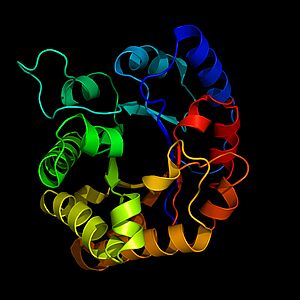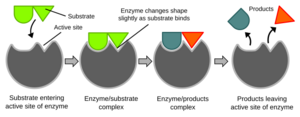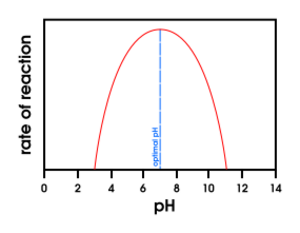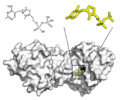Enzyme facts for kids
An enzyme is a special kind of protein molecule found inside cells. Think of enzymes as tiny biological helpers or catalysts. They make chemical reactions in your body happen much faster than they would on their own. The cool thing is, enzymes don't get used up during these reactions, so they can be used over and over again!
Almost every chemical reaction that happens in living things needs enzymes. Without them, many important processes would be too slow to keep you alive. There are also other biological helpers called ribozymes, which are made of RNA.
The chemicals that an enzyme starts working on are called substrates. After the enzyme does its job, the new chemicals it creates are called products. So, enzymes take substrates and turn them into products. Scientists who study enzymes are called enzymologists.
The first enzyme was discovered in 1833 by a scientist named Anselme Payen.
Contents
What Are Enzymes Made Of?
There are thousands of different enzymes, and each one is designed to do a very specific job. Enzymes usually have names that tell you what they do, and their names almost always end with –ase.
For example, ATP synthase is an enzyme that helps make a chemical called ATP, which is like energy currency for your cells. Another example is DNA polymerase, which helps build new strands of DNA.
You have enzymes in your body right now! For instance, amylase is an enzyme found in your saliva. It starts breaking down starch from your food into smaller sugar molecules like glucose and maltose. Another enzyme, lipase, breaks down fats into even smaller pieces called fatty acids and glycerol.
There's also a whole group of enzymes called proteases. Their job is to break down other enzymes and proteins back into their basic building blocks, which are amino acids. Nucleases are enzymes that can cut DNA or RNA molecules at specific spots.
Enzymes don't just break things down. Some enzymes build smaller chemicals into bigger, more complex ones. They perform many different chemical tasks to keep living things working.
Scientists often use special "ribbon models" to show the shape of an enzyme. This is because enzymes are made of hundreds or thousands of tiny atoms, and drawing every single one would be too complicated! Ribbon models help us see the overall shape of the enzyme without all the tiny details.
How Do Enzymes Work?
Most enzymes need the right conditions to work properly, especially the right temperature and pH (how acidic or basic something is). For mammals, like humans, the best temperature for most enzymes is around 37 degrees Celsius (your body temperature). However, the best pH can be very different for different enzymes. For example, pepsin, an enzyme in your stomach, works best in very acidic conditions, around a pH of 1.5.
If an enzyme gets too hot, it can be permanently damaged. This is called denaturation. When an enzyme is denatured, its shape changes, and it can no longer do its job.
Some chemicals can actually help an enzyme work even better. These are called activators. On the other hand, some chemicals can slow down an enzyme or even stop it from working at all. These are called inhibitors. Many medicines work by either speeding up or slowing down specific enzymes in the human body.
The Lock and Key Model
Enzymes are very specific about what they work on. In 1894, a scientist named Emil Fischer suggested that an enzyme and its substrate fit together perfectly, just like a lock and a key. This idea is called the "lock and key" model. It means that only a specific substrate can fit into a specific enzyme's active site (the part of the enzyme where the reaction happens).
However, in 1958, Daniel Koshland improved on this idea. He suggested that enzymes are actually a bit flexible. When a substrate comes close to an enzyme, the enzyme's active site can slightly change its shape to fit the substrate even better. This is called the "induced fit" model. It's like a glove molding to your hand. This slight change in shape helps the enzyme do its job more effectively.
Enzyme Reactions
The basic idea of an enzyme reaction can be shown like this:
- Substrate + Enzyme → Substrate:Enzyme → Product:Enzyme → Product + Enzyme
Enzymes make reactions happen faster by lowering the "activation energy." This is the amount of energy needed to start a chemical reaction. They do this by forming a temporary partnership with the substrate, called an enzyme-substrate complex.
For example, the enzyme sucrase is much bigger than its substrate, sucrose (table sugar). Sucrase helps break sucrose into two simpler sugars: glucose and fructose. The sucrase actually bends the sucrose molecule, putting stress on the bond between the glucose and fructose parts. Then, water molecules join in, and the bond breaks in a tiny fraction of a second!
Here are some key things about enzymes:
- They are catalytic: They speed up reactions incredibly fast, sometimes making them happen billions of times faster! The enzyme itself doesn't change during the reaction.
- They are effective in tiny amounts: Just one enzyme molecule can process thousands, or even millions, of substrate molecules every minute.
- They are highly specific: Each enzyme usually only carries out one specific type of reaction, even if a substrate could be involved in many different reactions.
How Enzyme Activity Is Controlled
Your cells have clever ways to control how much and how fast enzymes work. Here are five main ways:
- Making More or Less Enzyme: Cells can increase or decrease the production of an enzyme based on what they need. For example, some bacteria that are resistant to antibiotics like penicillin make more enzymes that break down penicillin.
- Location, Location, Location: Enzymes can be kept in different parts of the cell. For instance, enzymes that build fatty acids are in one part of the cell, while enzymes that use fatty acids for energy are in another part.
- Feedback Control: Sometimes, the final product of a reaction pathway can tell an enzyme at the beginning of the pathway to slow down. This is called negative feedback. It's like a thermostat for your cells, making sure they don't make too much of something. This helps keep your body's internal environment stable.
- Activation After Production: Some enzymes are made in an inactive form and only become active when they are needed. For example, chymotrypsin, an enzyme that helps digest food, is made in your pancreas in an inactive form. It only becomes active when it reaches your stomach, which prevents it from digesting your pancreas!
- Environmental Changes: Some enzymes become active when they move to a different environment, like one with a different pH. For example, a protein in the influenza virus becomes active when it enters the acidic conditions inside a host cell.
Enzyme Inhibitors
Inhibitors are molecules that can stop an enzyme from working or slow it down. They often do this by fitting into the enzyme's active site, preventing the substrate from binding properly. This can be useful if you want to slow down a specific reaction in the body.
Denaturation
Denaturation is when an enzyme's active site is permanently changed, usually because of extreme temperature or pH. This change is irreversible. When an enzyme is denatured, its shape is altered, and the substrate molecule can no longer fit into the active site. This means the enzyme can't do its job, and the reaction rate will decrease.
Cofactors
Cofactors, also called coenzymes, are like little helpers that many enzymes need to work properly. They are not proteins themselves. Some cofactors are organic molecules (like vitamins), and others are inorganic molecules (like metal ions such as Mg2+, Cu2+, Mn2+, or iron-sulphur clusters). These metal ions can help by donating electrons, which is important in many reactions. This is why your body needs trace elements and vitamins – they are essential cofactors for many enzymes!
Uses of Enzymes
Enzymes are not just important in your body; they are also used in many ways commercially:
- Baby food: Enzymes are used to pre-digest food for babies, making it easier for them to absorb nutrients.
- Softening chocolates: Enzymes can be used to soften the centers of chocolates.
- Biological washing powder: Many washing powders contain protease enzymes. These enzymes break down tough grime and dirt (which are often large, insoluble molecules) into smaller, soluble molecules that can be washed away. These enzymes often work well at lower temperatures, which saves energy.
Related pages
Images for kids
-
Problems with enzymes that are passed down through families are usually inherited in an autosomal way. This means they are not on the X-chromosome. They are also often recessive, meaning that if you have one working copy of the gene, you usually don't show symptoms.
See also
 In Spanish: Enzima para niños
In Spanish: Enzima para niños










